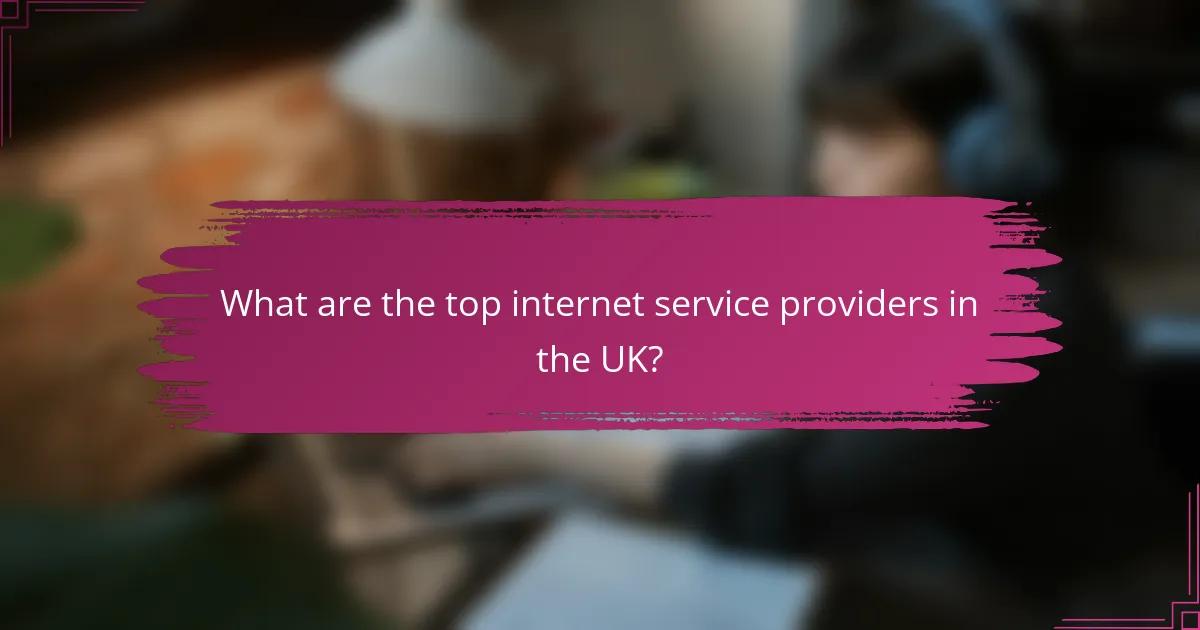Selecting the appropriate internet speed tier for your household is essential to ensure a seamless online experience. Factors such as the number of users, types of online activities, and connected devices play a crucial role in determining the best plan for your needs. By understanding these elements, you can choose a service that balances performance and cost effectively.

What are the best speed tiers for household internet in the UK?
The best speed tiers for household internet in the UK vary based on usage needs, with options ranging from basic browsing to ultra-fast connections. Choosing the right tier depends on the number of users, the types of online activities, and the devices connected to the network.
Basic tier: 10-30 Mbps
The basic tier, offering speeds between 10 and 30 Mbps, is suitable for light internet users. This includes activities such as browsing, checking emails, and streaming in standard definition on one or two devices simultaneously.
For households with minimal online activity, this tier can be cost-effective. However, users may experience buffering during peak times or when multiple devices are connected.
Standard tier: 30-100 Mbps
The standard tier, with speeds from 30 to 100 Mbps, is ideal for families or individuals who stream HD content, play online games, or work from home. This speed range supports multiple devices without significant slowdowns.
Consider this tier if your household has several users engaging in various online activities at the same time. It provides a good balance between performance and cost for most average users.
High-speed tier: 100-300 Mbps
The high-speed tier, offering 100 to 300 Mbps, caters to heavy internet users and larger households. This speed is beneficial for 4K streaming, online gaming, and simultaneous downloads across multiple devices.
Choosing this tier can future-proof your internet needs, especially as more smart devices connect to your network. It is a solid choice for those who prioritize speed and reliability.
Ultra-fast tier: 300+ Mbps
The ultra-fast tier, exceeding 300 Mbps, is designed for tech-savvy users and smart homes with numerous connected devices. This tier supports high-demand activities such as 8K streaming, large file uploads, and seamless video conferencing.
While this option may come at a higher cost, it ensures that even the most intensive online activities can occur without interruption. Consider this tier if you regularly engage in high-bandwidth tasks or have a large number of users in your household.

How to choose the right speed tier for your household?
Choosing the right speed tier for your household involves evaluating your internet usage, the number of devices connected, and specific needs like streaming and gaming. Understanding these factors will help you select a plan that meets your family’s demands without overspending.
Assess household internet usage
Start by analyzing how your household uses the internet. Common activities include browsing, video conferencing, and downloading files. For general browsing and streaming, a speed of 25-50 Mbps is often sufficient, while heavier usage may require 100 Mbps or more.
Consider the frequency and duration of internet use. If multiple family members are online simultaneously for work or school, higher speeds will ensure a smooth experience. Keep track of peak usage times to better understand your needs.
Consider number of devices
The number of devices connected to your network significantly impacts the required speed tier. Each device consumes bandwidth, so a household with several smartphones, tablets, and smart TVs will need more speed than one with just a few devices. A good rule of thumb is to allocate about 10-20 Mbps per device for optimal performance.
Evaluate both wired and wireless connections. Wired connections typically provide more stable speeds, while Wi-Fi may vary based on distance and interference. If you have many devices, consider upgrading to a higher speed tier to accommodate them all effectively.
Evaluate streaming and gaming needs
If your household enjoys streaming movies or gaming, these activities require higher speeds for optimal performance. For standard streaming, a speed of 5-10 Mbps per device is usually adequate, while HD streaming may require 15-25 Mbps. Gaming often needs 25 Mbps or more for a seamless experience.
Additionally, consider the quality of the content you consume. 4K streaming and online gaming can demand significantly higher speeds, often exceeding 50 Mbps per device. Assess your family’s viewing habits and gaming preferences to choose a speed tier that supports these needs without interruptions.

What are the top internet service providers in the UK?
The top internet service providers in the UK include BT, Virgin Media, Sky, and TalkTalk. Each offers a variety of plans catering to different household needs, from basic browsing to high-speed gaming and streaming.
BT Broadband
BT Broadband is one of the largest providers in the UK, offering a range of packages that include both standard and superfast broadband options. Their services are widely available, making them a reliable choice for many households.
When considering BT, look at their various speed tiers, which can range from around 10 Mbps to over 900 Mbps. This flexibility allows you to choose a plan that matches your internet usage, whether for casual browsing or heavy streaming.
Virgin Media
Virgin Media is known for its high-speed broadband, often providing some of the fastest speeds available in the UK. Their cable network allows for speeds that can exceed 1 Gbps, ideal for households with multiple users or heavy data needs.
Consider Virgin Media if you prioritize speed and reliability. Their packages often come with additional perks, such as access to streaming services, making them a popular choice for entertainment-focused households.
Sky Broadband
Sky Broadband offers a variety of packages that cater to different needs, including standard and fibre broadband. They are known for their competitive pricing and customer service, making them a solid option for many users.
Sky’s broadband speeds typically range from around 11 Mbps to 500 Mbps. They also provide options that bundle broadband with TV services, which can be beneficial if you’re looking for a comprehensive entertainment package.
TalkTalk
TalkTalk is recognized for its budget-friendly broadband options, making it a popular choice for cost-conscious consumers. They offer a range of plans, including fibre broadband, which can meet the needs of most households.
When choosing TalkTalk, keep in mind their speeds generally range from about 11 Mbps to 300 Mbps. Their no-frills approach can be appealing, but it’s worth checking for any additional fees or limitations that may apply to your chosen plan.

What are the costs associated with different speed tiers?
The costs for internet speed tiers vary based on the level of service and the provider. Generally, higher speed tiers come with increased monthly fees, reflecting the enhanced performance and bandwidth available.
Basic tier pricing: £20-£30/month
The basic tier typically offers speeds suitable for light browsing, email, and streaming in standard definition. This pricing range is ideal for individuals or small households with minimal internet usage.
When considering the basic tier, check for data caps and throttling policies, as some providers may limit usage after reaching a certain threshold. This tier is often sufficient for users who do not engage in heavy online activities.
Standard tier pricing: £30-£50/month
The standard tier provides a balance of speed and cost, catering to moderate users who stream in high definition and engage in online gaming. This range is suitable for families or multiple users sharing the same connection.
Before selecting a standard tier, assess your household’s internet habits. If several devices are connected simultaneously, this tier can help avoid slowdowns and buffering issues, making it a practical choice for most households.
High-speed tier pricing: £50-£70/month
The high-speed tier is designed for heavy users who require fast, reliable internet for activities such as 4K streaming, large file downloads, and online gaming. This pricing reflects the higher bandwidth and lower latency offered.
Consider the number of devices and the types of activities when opting for this tier. It is particularly beneficial for households with multiple users engaging in data-intensive tasks at the same time. Ensure that your router and home network can support these speeds for optimal performance.

What factors influence internet speed tier selection?
Choosing the right internet speed tier depends on various factors, including your household’s internet usage, the number of devices connected, and the types of online activities you engage in. Understanding these elements will help you select a plan that meets your needs without overspending.
Location and availability
Your geographic location significantly impacts the internet speed tiers available to you. Urban areas typically offer a wider range of high-speed options compared to rural locations, where choices may be limited to lower-speed plans.
Check with local internet service providers (ISPs) to see what speed tiers are available in your area. For example, some regions may only offer DSL or satellite options, while others might provide fiber-optic connections that support much higher speeds.
Contract length and flexibility
When selecting an internet speed tier, consider the contract length and flexibility offered by the provider. Many ISPs require a commitment of one to two years, which can lock you into a specific speed tier and pricing.
Look for options that allow for month-to-month contracts or easy upgrades and downgrades. This flexibility can be beneficial if your internet needs change over time, such as adding more devices or switching to remote work.



